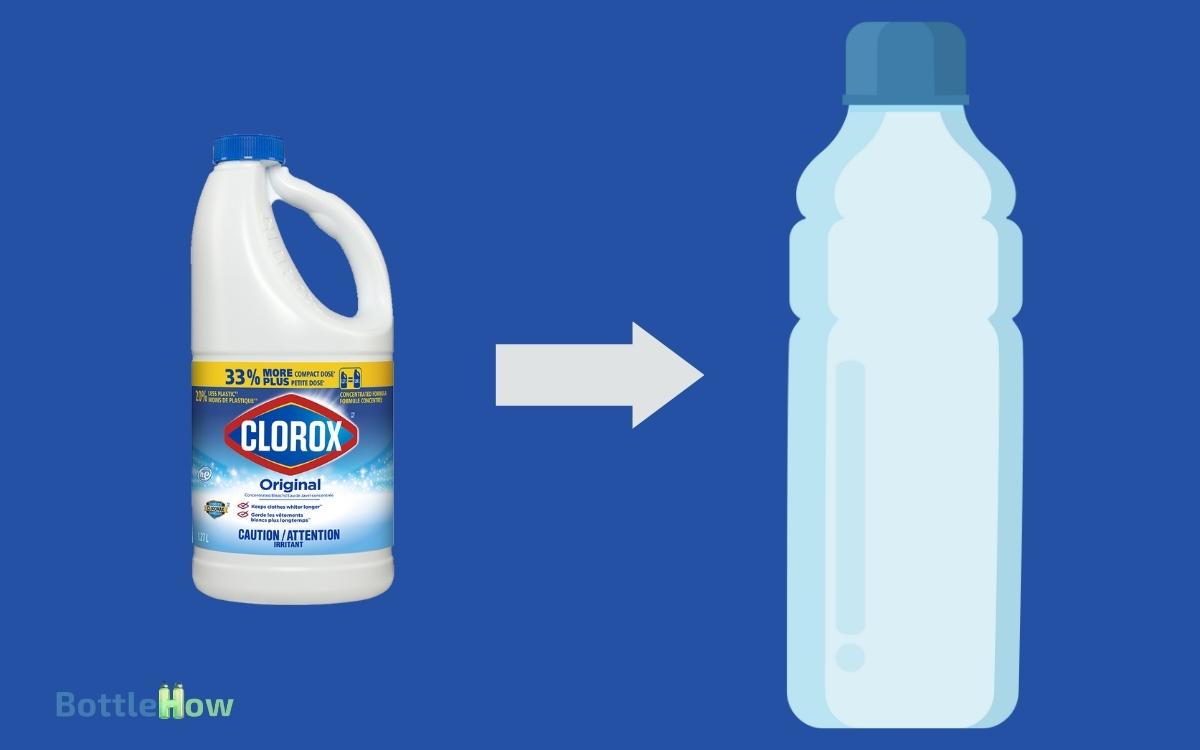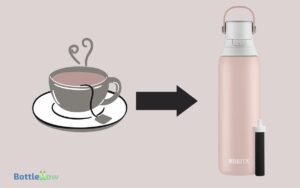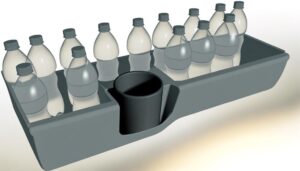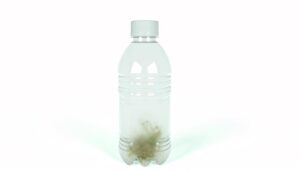Can You Put Bleach in a Plastic Water Bottle? No!
You shouldn’t store bleach in a plastic water bottle due to bleach’s strong oxidizing nature, which can react with certain plastics.
Most common plastic water bottles, like PET, can degrade and release harmful substances. Opt for HDPE or polypropylene containers marked for chemical compatibility.
When handling bleach, always use proper ventilation and protective gear. Store it in a cool, dry place, away from sunlight and tightly sealed to prevent leaks.
For safer alternatives, consider glass containers specifically designed for chemicals. To avoid potential health hazards and environmental impacts, following these guidelines is essential for safe bleach storage.
Learn about other safe storage practices as well.

Key Takeaways
Chemical Properties of Bleach
Understanding the chemical properties of bleach is essential before you consider putting it in a plastic water bottle.
Bleach, primarily composed of sodium hypochlorite, is a strong oxidizing agent. It can react with various materials, potentially leading to hazardous situations.
When you handle bleach, it’s important to know that it breaks down into salt and water, releasing chlorine gas, which is toxic. This decomposition can be accelerated by heat and light, making storage conditions essential.
Always make sure proper ventilation and use protective gear, such as gloves and goggles, to avoid direct contact.
Being aware of bleach’s reactivity with metals and certain organic materials helps prevent dangerous chemical reactions. Your safety hinges on understanding these properties and handling bleach with care.
Types of Plastic Water Bottles
Before you put bleach in a plastic water bottle, you need to understand the various types of plastics used. Each type has different levels of durability, safety, and chemical compatibility.
This knowledge guarantees you’re using a bottle that won’t degrade or release harmful substances when in contact with bleach.
Common Plastic Types
When considering the types of plastic water bottles, it’s important to distinguish between common materials like PET, HDPE, and LDPE, each with unique properties and safety implications.
PET (polyethylene terephthalate) bottles are lightweight and often used for single-use applications. They’re generally safe but not intended for long-term storage of harsh chemicals.
HDPE (high-density polyethylene) is more robust and can handle stronger chemicals, making it suitable for repeat use.
LDPE (low-density polyethylene) is flexible and often used for squeeze bottles; it’s less chemically resistant than HDPE.
Understanding these differences helps you choose the right bottle for specific uses, ensuring safety and effectiveness.
Always check the resin identification code and consult safety guidelines before using bleach or other chemicals.
Durability and Safety
Selecting the appropriate type of plastic for water bottles involves evaluating the durability and safety of materials like PET, HDPE, and LDPE, especially when storing substances like bleach.
PET (Polyethylene Terephthalate) is lightweight and strong but can degrade with repeated use and exposure to chemicals.
HDPE (High-Density Polyethylene) offers greater chemical resistance and durability, making it a safer option.
LDPE (Low-Density Polyethylene) is more flexible but less robust against harsh chemicals.
When choosing, consider the bottle’s structural integrity and its ability to resist chemical reactions.
Always follow safety protocols, such as using containers specifically designed for chemical storage, to make sure the plastic doesn’t weaken or leach harmful substances into the contents.
Chemical Compatibility
Understanding the chemical compatibility of different plastic water bottles is essential to guarantee safety and prevent chemical reactions when storing bleach.
Not all plastics react well with bleach, and choosing the wrong type can lead to dangerous leaks or degradation.
You need to know which plastics can safely hold bleach:
- High-Density Polyethylene (HDPE): Resistant to bleach, commonly used for bleach bottles.
- Polypropylene (PP): Also compatible but less common for water bottles.
- Polyethylene Terephthalate (PET or PETE): Not recommended, as it can degrade and leach chemicals.
- Polycarbonate (PC): Should be avoided due to potential chemical reactions.
Bleach and Plastic Interaction
When you place bleach in a plastic water bottle, consider the chemical compatibility to prevent reactions that could compromise the bottle’s integrity.
Verify the plastic’s durability to withstand bleach’s corrosive properties over time. Always follow safety usage guidelines to avoid harmful exposure and potential health risks.
Chemical Compatibility Concerns
It’s important to understand that bleach’s chemical properties can degrade certain types of plastic, potentially compromising both the bottle’s integrity and your safety.
When bleach interacts with plastic, it can cause:
- Chemical reactions: Some plastics react to bleach, releasing harmful byproducts.
- Structural weakening: Prolonged exposure can weaken plastic, leading to cracks or leaks.
- Toxic leaching: Degraded plastic may release toxins into the bleach solution.
- Compatibility issues: Not all plastics are bleach-resistant; using the wrong type can be hazardous.
You should always verify the compatibility of the plastic material with bleach before use. Consult safety data sheets and manufacturer guidelines to ensure proper selection.
Proper handling and storage are critical to maintaining safety and the effectiveness of your bleach solution.
Plastic Bottle Durability
To guarantee the durability of your plastic bottle when storing bleach, you must carefully consider the specific type of plastic and its resistance to chemical interactions.
High-density polyethylene (HDPE) and polypropylene (PP) are commonly used for bleach storage due to their robustness and chemical resistance.
Avoid plastics like polyethylene terephthalate (PET) and polyvinyl chloride (PVC), as they can degrade or leach harmful substances when exposed to bleach.
Always check the recycling code on your bottle; HDPE is typically marked with a ‘2’ and PP with a ‘5’. Make sure that the bottle’s integrity is intact, with no visible cracks or deformities. Store bleach in a cool, dry place to prevent accelerated degradation of the plastic material.
Safety Usage Guidelines
Make sure you always wear protective gloves and eyewear when handling bleach to prevent skin irritation and eye damage.
Bleach can be safely used in certain plastic water bottles, but you need to confirm the plastic is bleach-resistant. Look for bottles made of high-density polyethylene (HDPE) or polyethylene terephthalate (PET).
Follow these guidelines to guarantee safe use:
- Dilution: Always dilute bleach according to manufacturer instructions to avoid damaging the plastic.
- Ventilation: Use in a well-ventilated area to minimize inhaling fumes.
- Storage: Store the bleach solution in a cool, dark place to maintain efficacy.
- Labeling: Clearly label any bottle containing bleach to prevent accidental ingestion.
Risks of Storing Bleach
Storing bleach in a plastic water bottle poses significant risks due to chemical reactions and potential contamination.
Bleach is a strong oxidizing agent and can react with certain types of plastic, leading to chemical degradation.
This not only compromises the structural integrity of the bottle but also risks leaching harmful chemicals into the bleach.
Moreover, if the plastic bottle previously contained other substances, residual contamination could occur, reducing the bleach’s effectiveness and potentially creating toxic byproducts.
Always use containers specifically designed for bleach storage, typically marked with a ‘HDPE’ (high-density polyethylene) label. Make sure the container is clean and has a tight-fitting cap to prevent spills and fumes.
Proper storage minimizes hazards and maintains the bleach’s potency.
Signs of Plastic Degradation
You’ll notice plastic degradation when the bottle starts showing signs like discoloration, brittleness, or cracks, all of which indicate the plastic’s compromised integrity.
Recognizing these signs is essential for safety, as degraded plastic can lead to chemical leaching and potential health hazards.
Key indicators to watch for include:
- Discoloration: Fading or yellowing suggests UV or chemical damage.
- Brittleness: The plastic feels less flexible and more prone to breaking.
- Cracks: Visible fissures or splits that weaken the structure.
- Texture Changes: A rough or uneven surface indicates molecular breakdown.
Keep an eye out for these signs to ensure your containers remain safe and effective. Always follow safety protocols to prevent potential risks associated with degraded plastic.
Safe Containers for Bleach
When selecting containers for bleach, choose those made from high-density polyethylene (HDPE) or polypropylene (PP) to guarantee chemical compatibility and prevent degradation.
These materials are resistant to the corrosive nature of bleach and won’t break down over time. Avoid using containers made from low-density polyethylene (LDPE), polycarbonate (PC), or polyethylene terephthalate (PET) since bleach can weaken these plastics, leading to leaks or contamination.
| Material | Compatibility with Bleach | Risk Level |
|---|---|---|
| HDPE | High | Low |
| PP | High | Low |
| LDPE | Low | High |
| PC | Low | High |
| PET | Low | High |
Stick to HDPE or PP containers for storing bleach to guarantee safety and longevity.
Proper Bleach Storage Tips
To guarantee bleach remains effective and safe to use, store it in a cool, dry place away from direct sunlight and heat sources.
Temperature fluctuations can degrade bleach, reducing its disinfectant properties. Always keep the container tightly sealed to prevent leakage or contamination.
- Original Container: Store bleach in its original, labeled container to avoid chemical reactions or confusion.
- Ventilation: Make sure the storage area is well-ventilated to avoid the buildup of fumes.
- Childproof Location: Keep bleach out of reach of children and pets to prevent accidental ingestion or spills.
- Segregate Chemicals: Don’t store bleach near acids, ammonia, or other chemicals to prevent dangerous reactions.
Environmental Impact
Understanding proper bleach storage is only part of the equation; you also need to consider its environmental impact to guarantee safe and responsible use.
When bleach is improperly stored or disposed of, it can leach into soil and water systems, causing harm to aquatic life and contaminating drinking water.
To mitigate this, always use designated hazardous waste disposal sites for bleach. Never pour bleach down drains or into outdoor environments, as it can form toxic compounds when mixed with other chemicals.
Make sure your plastic water bottle is made of high-density polyethylene (HDPE) if you must store bleach temporarily, as it’s less likely to degrade and release harmful substances.
Adhering to these protocols helps minimize environmental damage.
Alternative Storage Solutions
Consider using glass containers with airtight seals as an alternative to plastic bottles for storing bleach, as they offer better chemical resistance and reduce the risk of leaching.
Glass doesn’t interact with bleach, ensuring the chemical’s stability and effectiveness. Always choose containers specifically designed for chemical storage to prevent accidents.
Here are some benefits of using glass containers:
- Chemical Resistance: Glass doesn’t react with bleach, maintaining its potency.
- Durability: High-quality glass is less likely to degrade over time.
- Safety: Airtight seals prevent leaks and protect against spills.
- Environmental Impact: Glass is recyclable and reduces plastic waste.
Always handle bleach with care, following safety protocols like wearing gloves and working in well-ventilated areas to avoid harmful fumes.
Conclusion
So, can you put bleach in a plastic water bottle? The answer is clear: avoid it. Bleach’s chemical properties can degrade plastic, leading to leaks and potential hazards. This degradation weakens the bottle over time, making it unsafe for storing liquids. Instead, it’s best to use containers specifically designed for chemical storage to prevent accidents. Similarly, you might wonder, can you put alcohol in metal bottles? The type of metal and alcohol concentration determine whether it’s safe, as certain metals can corrode or react with alcohol.
Always use containers specifically designed for chemicals. Look for signs of plastic degradation and prioritize safety protocols. Proper storage not only guarantees your safety but also protects the environment.
Instead, opt for alternative storage solutions like glass or high-density polyethylene (HDPE) containers, which are safer and more reliable.






